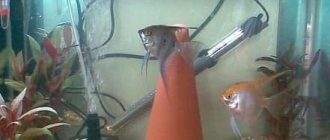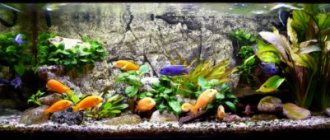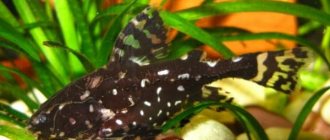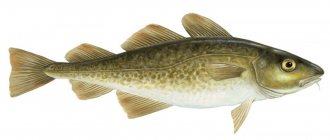Hello to all readers of my blog! I didn't like thorns before. Their nondescript color did not decorate the aquarium, and the fish themselves were inconspicuous and probably therefore uninteresting. Well, the rest of the thornets: unpretentious, omnivorous, peaceful, and resistant to various diseases.
With the advent of various color variations, the attitude towards thorns has also changed. Now these fish are elegant and clearly visible, and in one school there can be multi-colored individuals and it looks very beautiful and original.
What does it take for spawning fish to reproduce?
In essence, after reaching sexual maturity, all individuals are ready to reproduce, but the aquarist needs to provide certain conditions that will trigger the biological mechanism to start.
In nature, Ternetias reproduce during the warm rainy season, when large amounts of food appear in reservoirs.
Therefore, the owner of the fish must recreate similar conditions in the aquarium.
Sexual maturity of individuals
Ternetias become sexually mature at approximately 7 months. Only those fish whose age ranges from 8 months to 2 years are suitable for spawning.
In addition, an adult must have a fairly long body by the standards of this species (at least 4-5 cm). Small fish and old individuals will not be able to fully produce eggs.
Habitat conditions
To stimulate spawning it is necessary:
- increase the water temperature by 2-3 degrees;
- fish that are chosen as “parents” must be kept on a starvation diet during the day, and then fed generously with live food (daphnia, coretra or bloodworms are suitable).
If the aquarium contains only Ternetia, then there will be no problems in providing suitable conditions. An increase in temperature may negatively affect some neighbors , and other fish may take all the live food from Ternetia. For these reasons, preparation for spawning is often carried out in a separate aquarium.
However, situations often arise when Ternetia begin to breed in a common aquarium, and the owner is not aware of the process until the spawning itself.
Ternetia aquarium fish - description of a common beauty
With the appearance of an aquarium in the interior, the appearance of this room acquires that very cozy zest that we so dream of. This effect is achieved thanks to the variety of shapes and colors of the fish living in it.
Ternetia is a fish that can form the basis of a carefree aquarium. It's all about her impeccably easy-going character. It seems that nothing and no one will change her measured way of life. In addition, it is not a small baitfish, and, therefore, you can observe it without a magnifying glass. The size of an adult thorn fish is from 4 cm to 6 cm.
Ternetia - peaceful fish
How else can you recognize it among all the fish diversity? The differences in appearance are:
- the body has a flattened appearance on the sides;
- the color of scales in one subspecies differs from another depending on the varieties of selection, but the classic one is gray with silver;
- dark stripes are visible on the body, there are three of them: the first is located near the eye, the second seems to connect the upper and lower fins, and the third is closer to the tail;
- the lower fin is connected to the anal fin, so the entire abdomen is as if bordered by a flounce;
- the tail is transparent and the fins are black;
- There are differences by sex, the female is larger in all respects.
A flock of thornets
Aquarium thornets can have a calming effect on children's visual perception, and adults definitely like it. Her movements are not rapid, they are smooth, so we can safely recommend her as an object for a glass mini-pond in a children's room.
Pregnant female, example photo
To be precise, the female Ternetia cannot be called pregnant, since she does not give birth to live fry, but only collects and lays eggs. Despite this, for convenience, this term is most often used.
It is recommended to switch the fish to live food, which may consist of daphnia, bloodworms or various larvae.
If everything goes correctly, then after about a week it will become noticeable that some of the fish have become rounder - this is what the females look like with caviar inside.
Ternetia is pregnant.
Signs
Since you have raised the temperature in the aquarium and started giving live food to the Ternetias, you need to carefully monitor the females. If the environmental conditions are suitable for the fish, then after 1-1.5 weeks the “girls” will develop a noticeable rounded abdomen. Beginners may even think that Ternetia gives birth to fry live, but in fact, a large number of eggs ripen inside the female’s abdomen.
How to understand that the female is ready?
As spawning approaches, Ternetius females will begin to hide, while males, on the contrary, will become very active. “Boys” can surround “girls”, chase them around the entire aquarium and press them against the walls.
Pregnant Ternetia in an aquarium.
What to do if you find a pregnant fish?
As already mentioned, sometimes preparation for spawning occurs independently and unnoticed by the fish owner.
Pregnant females must spawn all their eggs; it is not even planned to receive offspring from Ternetia in the future.
What happens if the fish is not allowed to spawn?
If spawning does not take place on time, then the eggs inside the fish will overripe, and they will no longer produce fry. In addition, in the absence of spawning, the eggs in the female’s body turn into a cyst (tumor), which will lead to serious health problems and death.
Diseases
Caramels have weaker immunity than their natural form. In an aquarium with irregular hygiene, fish are susceptible to:
- poisoning;
- hypoxia;
- costiosis;
- microbacteriosis;
- ichthyophthyriasis;
- oodiniumosis.
Prevent the occurrence of diseases:
- preparing a varied diet;
- weekly soil siphoning and water changes;
- timely identification and treatment of diseased fish;
- processing of new plants and soil, live food;
- quarantine for new fish;
- monitoring of water quality and parameters.
Breeding at home, instructions with photos for beginners
Spawning of Ternetius, as a rule, takes place without any problems. However, the aquarist needs to take good care of the fish if he plans to breed from them.
Where to spend it?
It was noted above that spawning is most often recommended to be carried out in a separate container. In a community aquarium it is difficult to provide suitable conditions for the “parents”, eggs and emerging fry.
Ternetia Glofish preparing for spawning.
Breeding in a separate aquarium
A separate aquarium (spawning ground) must be prepared in advance; a tank with a volume of at least 20 liters will do. It is important to ensure the following water parameters:
- temperature – from 24 to 28 °C;
- hardness – 5-10°dH.
The water must be soft (boiled or melted), and a heater and an aerator must be installed in the tank. At the same time, the fish cannot be suddenly moved to other conditions, so part of the water should be taken from the general aquarium.
Additional lighting in the spawning area is not required, since natural light is perfect for Ternetia. The container itself should be located in a secluded and quiet place, away from direct sunlight and various sources of irritation.
Many aquarists recommend placing Java moss on the bottom of the aquarium to protect the eggs. The fact is that during spawning, adult individuals lose a lot of energy, and to replenish their strength, they immediately eat their offspring. If you are spawning with the aim of producing offspring, then inside the spawning area it is worth placing a special mesh with small cells, which will reliably protect the eggs from hungry “parents”.
Ternetius spawns in an aquarium with a net.
How to breed in a community aquarium?
In fact, spawning can be carried out in a community aquarium. This is usually done by those aquarists who do not need Ternetius fry, since preserving and raising offspring in a common container will be extremely problematic.
Preparing for spawning
Some aquarists release Ternetius into the spawning area, already ready for spawning, others select the most suitable fish and “start” the breeding process in a separate aquarium, and not in a common tank. In any case, the fish need to be moved in the evening so that they get used to the new conditions overnight.
Spawning of Ternetia.
If adaptation is successful, then the very next morning the males can begin chasing pregnant females. Sometimes fish take a long time to get accustomed to a new place, so spawning can occur after a week.
It is important to continue feeding your fish with live food, monitor the recommended water parameters and clean the aquarium.
Ternetias are unlikely to reproduce if they are not properly cared for.
The process itself
If spawning does begin (usually this happens early in the morning), then the males actively chase the females, press them against the walls and circle in close proximity to them. During spawning, Ternetius females gradually lay eggs, which are immediately fertilized by males. Then the eggs settle at the bottom, under cover, and the females continue spawning, which can last 2-3 hours. On average, Ternetia produces more than a thousand eggs, but not all of them will be viable.
Caviar Ternetsia Caramel.
Does the process need to be repeated?
As a rule, pregnant Ternetia spawn every two weeks 4-5 times in a row, so the whole process can take 2-3 months.
After the first spawning, the fish must be returned to the spawning area so that they can get rid of all the eggs.
What to do if nothing works out?
If the fish spent 2 weeks in the spawning area, but spawning did not occur, then the females and males should be returned to a common aquarium, or placed in different containers. It is worth analyzing the possible reasons for the failure:
- there is inappropriate water in the spawning area, and the conditions are very different from the general aquarium;
- fish disease, lack of appetite (we recommend reading an interesting article about popular diseases of Ternetius);
- irritating conditions in the room (loud sounds, bright lights);
- Incorrect age and size of Ternetius.
The problems that have arisen must be corrected, and then the fish must be put back into the spawning area.
Contents of the ternation
The aquarium is home to more than just Ternetia fish. Of course, when arranging it, you need to take into account the needs of each resident. Therefore, let’s talk in particular about the maintenance of these fish.
Temperature is very important for thornets, because depending on it, the color of the fish’s scales can change from black to almost transparent. Buy a heater that can be adjusted very precisely. The rule for setting is: 1 watt corresponds to 1 measure of volume. This way you can easily create a comfortable temperature from 22 to 26 degrees depending on the season. An exception is for glofish fish - they need a 28-degree environment.
Bright fish - Ternetia glofish
For thorns, the calculation of how many liters should be per fish does not differ from the general rules: for each centimeter of the body, stock up on two liters of water.
In general, the volume of the aquarium should be at least 60 liters. This will give freedom in swimming and the possibility of less contact with other fish, and the pets’ nervous system will remain unshakable.
Ternetias get along well with neons
Also, for peace of mind, create a school of fish of up to 10 pieces, this way you will save the thorn from loneliness, which threatens to result in an aggressive attitude towards other aquatic inhabitants.
Equip your home aquarium with an internal filter that has a pump - this way you can avoid the appearance of swampy stagnation.
Classic thorn
Find a way to introduce oxygen into the water. This can be done using a compressor. Otherwise, the fish will start fighting for every air bubble.
Fish also really need lighting, but when choosing a lamp, choose those models that do not heat the water. After all, this can lead to additional evaporation of the liquid.
Change the water regularly. It is possible to determine the immediate need for this process using special litmus tests. This way you can easily recognize the moment when 30% of the water needs to be changed, and the soil needs to be cleaned of silt and food residues.
Ternetia white
As we have already said, the common thorn comes in black or gray-silver colors. But in pet stores, customers will be offered it in several colors, and even with unusual fins. And knowing how things are with a great many fakes, any of us will doubt: is this the right fish in front of me?
Veil thorn - simplicity and grace
What do thornets - fish - look like in all their diversity? There are these types:
- classic black or silver scales;
- with veil-like fins;
- stripeless pink albino;
- artificially colored caramel colors;
- genetically modified GloFish.
Caring for eggs after spawning, raising fry from eggs and photos
As already mentioned, they need to be returned to the general aquarium so that they cannot destroy the eggs. In the spawning area, it is necessary to change about 25% of the water and add a little aqueous solution of Methylene blue 1%, which will ensure disinfection of the container from various fungi and parasites. The temperature in the aquarium is not lowered; the lighting can be dimmed even more.
Caviar of Ternetia.
If everything is done correctly, then in about a day the larvae will begin to hatch from the eggs. At first, they do not move at all and simply take up space on the bottom, plants and other surfaces. Fish larvae are equipped with a yolk sac, from which they initially receive nutrients. After 4-6 days, the sac will disappear, by that time the larvae will have grown up (become fry) and will begin to look for food.
Arrangement of the aquarium
For spawning, you should set up a separate aquarium and create favorable conditions for reproduction. The volume of the spawning tank is calculated based on 10-15 liters per couple. The optimal volume is 30-40 liters with a bottom area of 1500 cm2. The container can be made of acrylic or all glass.
The bottom is covered with river sand or small pebbles and plants with small leaves are planted. The tops of the “plantings” should not touch the surface of the water. The layer of water above them should be 5-6 cm. The bottom of the spawning tank can be covered with a fine mesh.
The water in the container also differs in characteristics from the liquid in a general aquarium:
- pH – 6.5-7.0;
- dN – 5-10°;
- t – 25-28°С.
Under these conditions, even if the couples are not yet completely ready for fertilization, after 3-6 days they will begin spawning.
Fry and care for them
From the moment the fry become active, it is necessary to return good lighting.
It is especially important during this period to monitor the cleanliness of the water; for this purpose, you can even place several snails in the spawning area. Up to 25% of the total water volume should be changed every day.
Little Ternetias need to be fed small meals frequently (at least 4 times a day). They should be given special dry food intended for fry, crushed live food and live dust (solution with ciliates).
A week old fry of Ternetia.
The fry develop unevenly; strong individuals often eat weaker ones. If an aquarist wants to keep as many pets as possible, he needs to sort the fish and place the largest Ternetius in a separate container. After 1-1.5 months, all the fry can be moved to an “adult” aquarium, if no one threatens them.
A three-week-old fry of Ternetia.
Compatibility
The compatibility of thorns with other fish depends on the type of neighbors. You should not keep pets with aggressive, large or small fish, as well as with veil fins, as large wavy fins will attract the attention of thorns - the fish will bite and chase the luxurious neighbor. A good neighborhood option would be to have pets with the following species:
- gourami;
- philanthropists;
- catfish;
- neons;
- tetras.
How do they reproduce depending on the species?
Almost all species of Ternetia reproduce in exactly the same way, but it is worth talking about the colored species in more detail. Caramels, as you know, get their bright color through subcutaneous injections with a coloring pigment, so their offspring will be dark gray, like ordinary Ternetias.
Glofish, in turn, acquired an unusual color thanks to genetic modification, and the introduced genes are inherited.
Their fry will have the colors of their parents, so the aquarist can feel like an experimenter, crossing different colored males and females. Some individuals in the Glofish litter may also be colorless, but this happens quite rarely.
Breed nuances
The common thorntail has an olive-gray body color, two black stripes running from the back to the belly, and the tail area and fins are dark. But there are also artificially bred breeds with bright colors: yellow, green, purple, orange, crimson and blue belly. This fish looks great in an aquarium, but when breeding it is not always possible to get equally beautiful fry. The fact is that there are two types of color ternation:
- caramel thorns , colored using special injections;
- Ternetia glofish are genetically modified fish, the DNA structure of which included the genes of luminous jellyfish and corals.
Glofish fry completely take on the color of their parents, unlike caramels, whose offspring are born colorless. Therefore, if you plan not only to keep thornets, but also to breed them, then it is better to purchase the Glofish breed. They differ from caramels in their more intense and uniform color. Of course, even in a glofish litter, several fry may be colorless, but the main percentage of babies will still take on the color of their parents.











